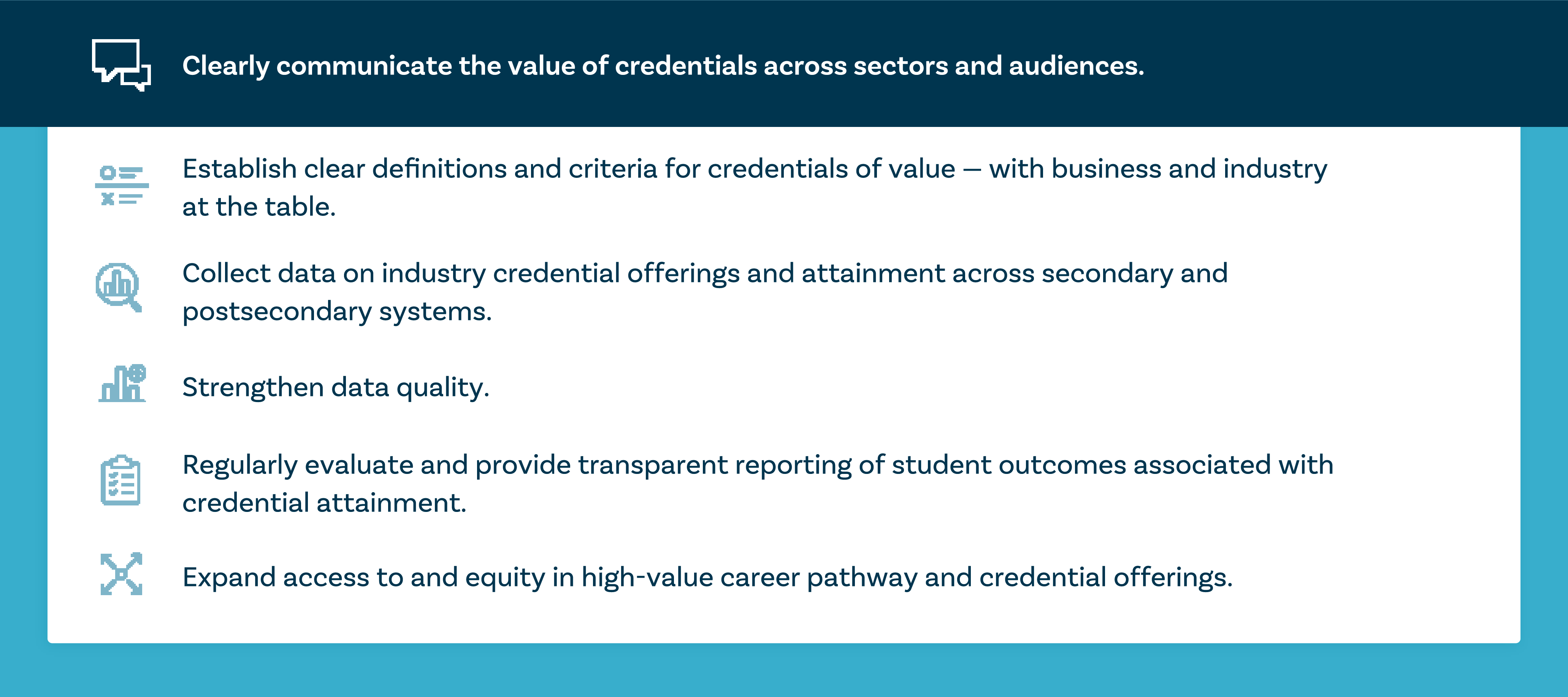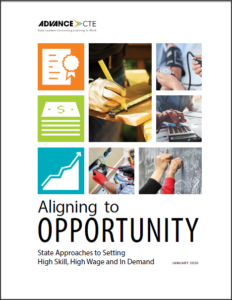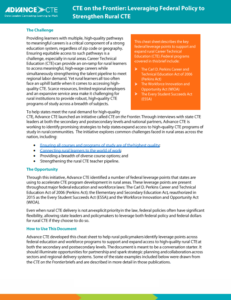![]() In October, Advance CTE released “The State of Career Technical Education: An Analysis of States’ Perkins V Priorities” which examines how states have leveraged the development of the Strengthening Career Technical Education for the 21st Century Act (Perkins V) state plans to expand quality and increase equity within their CTE systems. One finding of this report is the emerging state focus on credentials of value.
In October, Advance CTE released “The State of Career Technical Education: An Analysis of States’ Perkins V Priorities” which examines how states have leveraged the development of the Strengthening Career Technical Education for the 21st Century Act (Perkins V) state plans to expand quality and increase equity within their CTE systems. One finding of this report is the emerging state focus on credentials of value.
Perkins V introduces a new secondary program quality indicator as one method available to states to ensure program quality. States can choose from three options — work-based learning, recognized postsecondary credentials (credentials of value) and postsecondary credit attainment (dual enrollment and articulation) — all of which are components of a high-quality CTE program of study, in addition to other critical elements like rigorous standards, quality assessments and alignment to high-skill, high-wage and in-demand career opportunities. States’ increasing focus on credentials shows up in many aspects of their Perkins V plans, as shown in the chart below. That should come as little surprise. Credentials that are valued in the labor market can serve as an important component of any quality CTE program. They serve as anchors for the exit and re-entry points within CTE programs and career pathways, providing learners with a valuable way to signal their knowledge and skills to prospective employers and other postsecondary educational institutions.
The commitment to expanding credentials shows up in many aspects of state Perkins V plans, based on Advance CTE’s analysis:
- 43 percent of states (22 total) have selected recognized postsecondary credential attainment as at least one of their secondary CTE program quality measures.
- 41 percent of states are requiring credentials as part of the state’s program approval process.
- 27 percent of states reference developing or maintaining state-developed lists of approved credentials of value to ensure that credentials are quality and valued by the labor market.
Which Credentials States Promote Matters
Despite their popularity, credentials are not all created equally. As ExcelinEd found in its research, states are in very different places in terms of the ways that they identify, align, prioritize and measure credentials of value earned by learners across secondary and postsecondary systems. Consider that prior to Perkins V state plan approval:
- Many states do not collect data on credentials earned by K-12 and postsecondary learners.
- Just over half of all states (30) submitted K-12 quantitative data on the attainment of credentials for phase 2.
- No state is highly aligned in terms of supply for credentials earned by learners and the demand for those credentials in the job market.
- Only 18% of the credentials earned by K-12 learners in this analysis are in-demand by employers or are associated with occupations that pay a base wage of $15 per hour.
While these findings show that all states can improve their policies related to credentials of value, Perkins V offers states a platform to increase their focus on credentials of value as a critical component of high-quality CTE programs of study that lead to high-skill, high-wage and in-demand careers.
State Innovations
- In preparation for its Perkins V plan implementation, Texas developed a set of rigorous programs of study that are aligned to high-wage, high-skill and high-demand occupations. They include vertical alignment to postsecondary programs and, where appropriate, stackable credentials valued by employers.
- Pennsylvania’s Perkins V plan builds upon a 2019 amendment that requires all statewide articulation agreements, including those that award credit for industry-recognized credentials, to be reported and accessible to learners in an effort to increase transparency of how credentials can help accelerate learners along a career pathway
- Michigan is using the Reserve Fund to establish a competitive grant application process to identify credentials and align them with the course standards for CTE programs of study.
The Work Ahead
It is promising that states have included various references to credentials of value in their Perkins V plans. To help ensure they address core issues of quality and alignment, Credentials Matter offers six high-level recommendations for all states to develop statewide systems and processes that prioritize high-value credentials.

States should be lauded for making plans to include and improve access to industry credentials as part of comprehensive CTE offerings. Their next step is to execute on the implementation strategies that will ensure these offerings pay dividends to learners and families, while maintaining a steadfast commitment to quality and equity.
Resources
- Advance CTE Resource Center: Credentials and Assessments
- The State of Career Technical Education: An Analysis of States’ Perkins V Priorities
- Credentials Matter for Today’s Students
- Measuring Secondary CTE Program Quality: Postsecondary Credit Attainment
- Credential Currency: How States Can Identify and Promote Credentials of Value
- Policy Benchmark Tool: CTE Program of Study Approval
- Model Policy: Prioritizing High-Value Industry-Recognized Credentials
Christina Koch, Policy Associate
Melissa Canney, Innovation Policy Director, ExcelinEd


 The Strengthening Career and Technical Education for the 21st Century Act (Perkins V) places a strong emphasis on the alignment of Career Technical Education (CTE) programs of study with state, regional and local economies. The legislation requires Perkins-funded programs to prepare students for “high-skill, high-wage, or in-demand occupations.” These terms — high skill, high wage and in demand — are foundational to Perkins V, appearing in both the purpose of the law and the definition of CTE.
The Strengthening Career and Technical Education for the 21st Century Act (Perkins V) places a strong emphasis on the alignment of Career Technical Education (CTE) programs of study with state, regional and local economies. The legislation requires Perkins-funded programs to prepare students for “high-skill, high-wage, or in-demand occupations.” These terms — high skill, high wage and in demand — are foundational to Perkins V, appearing in both the purpose of the law and the definition of CTE. Building on interest from our members – and support from the Bill & Melinda Gates Foundation and Joyce Foundation – we decided to host another round of three Perkins V implementation meetings, joined once again by our excellent partners. Over the course of three months, we brought together about 300 leaders from across 44 states and Washington, DC, along with invited national CTE and workforce development experts from over 20 partner organizations, including National Skills Coalition, National Governors Association, ExcelinEd, Council of Chief State School Officers, New America, Education Strategy Group and others, to help states:
Building on interest from our members – and support from the Bill & Melinda Gates Foundation and Joyce Foundation – we decided to host another round of three Perkins V implementation meetings, joined once again by our excellent partners. Over the course of three months, we brought together about 300 leaders from across 44 states and Washington, DC, along with invited national CTE and workforce development experts from over 20 partner organizations, including National Skills Coalition, National Governors Association, ExcelinEd, Council of Chief State School Officers, New America, Education Strategy Group and others, to help states: At each meeting, states had the chance to present on their draft plans and strategies and get direct, actionable feedback from their peers and the invited partners. State leaders dug in deeply on issues including improving the quality of CTE programs/programs of study, closing equity gaps, leveraging the Comprehensive Local Needs Assessment to drive local innovation and learner-focused programming, aligning CTE and workforce development, and meaningful engagement of key stakeholders, such as Tribal communities and employers.
At each meeting, states had the chance to present on their draft plans and strategies and get direct, actionable feedback from their peers and the invited partners. State leaders dug in deeply on issues including improving the quality of CTE programs/programs of study, closing equity gaps, leveraging the Comprehensive Local Needs Assessment to drive local innovation and learner-focused programming, aligning CTE and workforce development, and meaningful engagement of key stakeholders, such as Tribal communities and employers.

 After a contentious confirmation hearing and an unprecedented vote requiring Vice President Mike Pence to break a Senate tie, Betsy DeVos was confirmed as President Donald Trump’s Secretary of Education on February 7. In her first weeks on the job, Secretary DeVos
After a contentious confirmation hearing and an unprecedented vote requiring Vice President Mike Pence to break a Senate tie, Betsy DeVos was confirmed as President Donald Trump’s Secretary of Education on February 7. In her first weeks on the job, Secretary DeVos